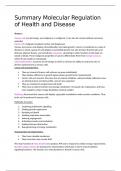Samenvatting
Summary Molecular Regulation of Health and Disease, HAP31806
Summary of the reader from Molecular Regulation of Health and Disease, HAP31806. Course is given in the first year of the MSc Biotechology at Wageningen University.
[Meer zien]




